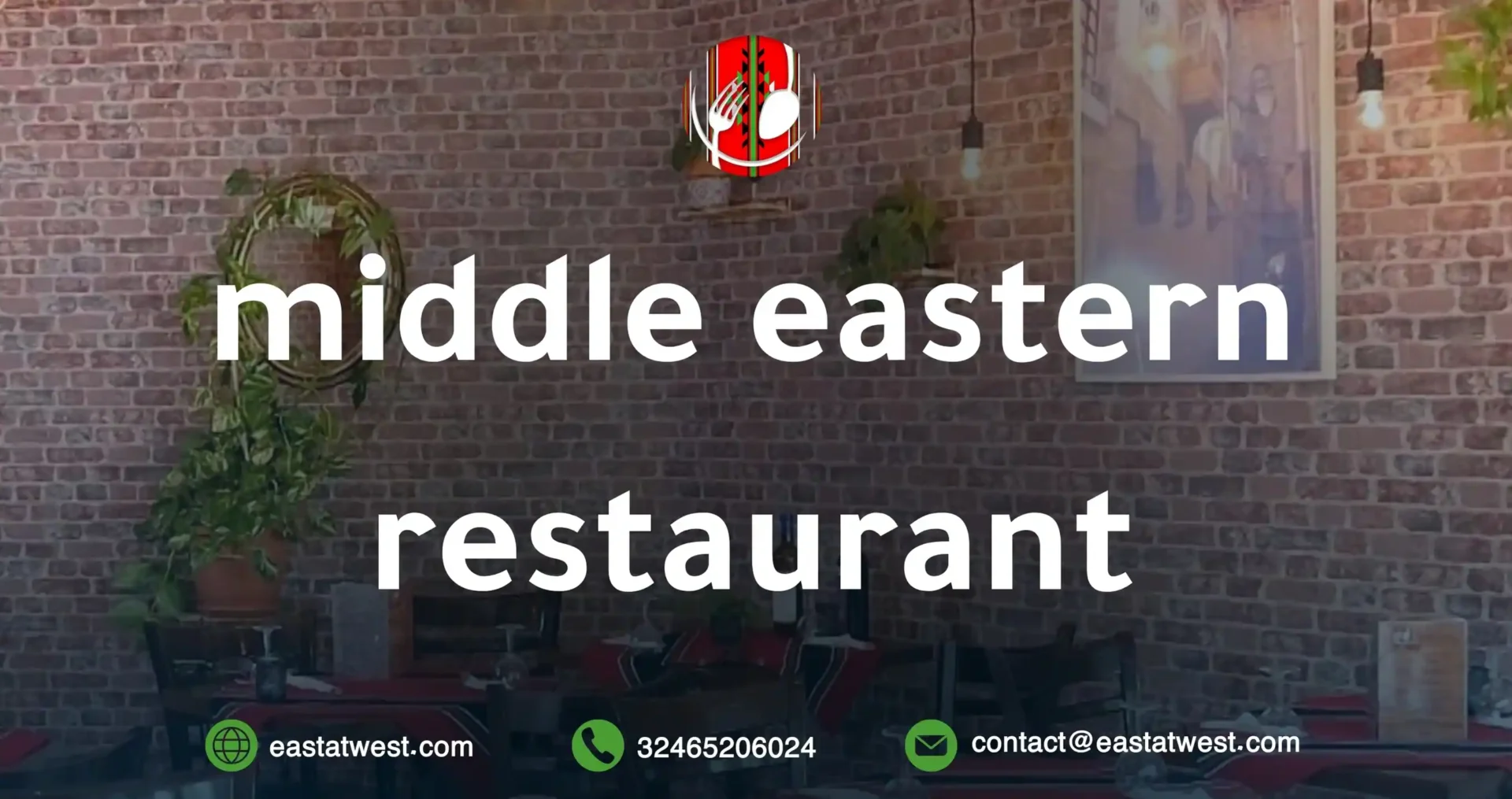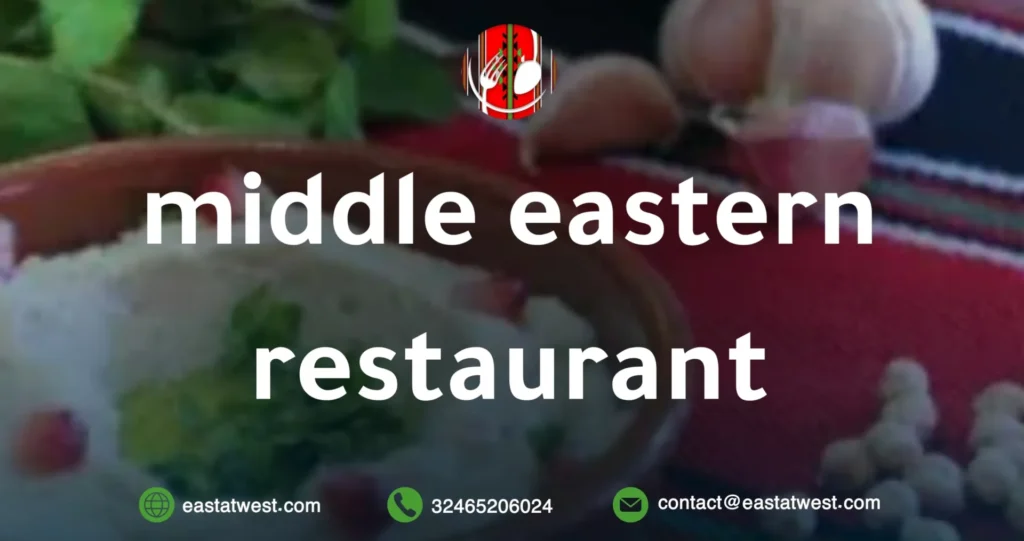
This is a comprehensive guide to Middle Eastern food in a Middle eastern restaurant, which includes a look at some regional differences as well as the most important components, cuisines, street food, snacks, desserts, and beverages.
Middle eastern restaurant
The rich culinary heritage of the Middle Eastern restaurant, which includes flavorful dishes like hummus, falafel, and shawarma, often overlaps with that of a Mediterranean cuisine restaurant offering a diverse array of dishes that highlight fresh ingredients, bold spices, and traditional cooking methods.
- Bahrain
- Cyprus
- Egypt
- Iran
- Iraq
- Jordan
- Kuwait
- Palestine
- Lebanon
- Oman
- Qatar
- Saudi Arabia
- Syria
- Turkey
- United Arab Emirates
- Yemen
This is referred to as West Asian or Arab cuisine. It also encompasses the regions of Mashreq and Maghreb. The variety of this cuisine reflects the many different ethnic and cultural groups that call these areas home.
Common items such as:
- Olives
- Olive oil
- Pitas
- Honey
- Sesame seeds
- Dates
- Sumac
- Chickpeas
- Mint
- Rice
- Parsley
These are used in the cuisine.
- Kebabs
- Dolmas
- Falafel
- Baklava
- Yogurt
- Doner kebab
- Shawarma
- Mulukhiyah
These are among the many delicacies it offers.
- Hummus
- Baba ghanoush
- Asida
- Ahriche
These are among other noteworthy meals. A range of sweets, like lauzinaj, a confection made with almonds, are also part of the cuisine.
In addition to being the cradle of civilization, the Middle East is also the origin of a highly significant culinary style. Middle Eastern cuisine is a delectable blend of traditional cooking methods, robust spices, and fresh ingredients. As varied and unique as the cultures of the 18 nations that make up its membership are its specialties.
Along with traditional staples like bread, rice, cheese, and olives, Middle Eastern cuisine also features well-known specialties like:
- Falafel
- Hummus
- Shish kebabs
- Shawarma
- Baklava
In order to create complex flavor profiles, it frequently contains:
- Olive oil
- Sesame seeds
- Fresh herbs
- Seasonings including nutmeg, turmeric, coriander, cumin, saffron, and sumac
Although there is a vast array of Middle Eastern flavors and recipes, we have tried our best to distill the spirit of the region.
What qualifies it as a Middle Eastern restaurant?
- Garlic
- Cumin
- Coriander-scented meats and seafood
- Garlic
- Oregano
- Lemon, or even a touch of cinnamon
- Marinated and kebabbed meats
- Vegetables
- Spicy stuffed vegetables
- Minted yogurt
- Salads with goat’s cheese and pomegranate “jewels”
- Dishes made with eggplant
- Tomatoes, and onions
- Honey-soaked pastries with ground nut fillings
- Accents of citrus and dried fruit
What Qualifies Middle Eastern restaurant as Mediterranean?

Here are a few of the two cuisines’ comparable techniques or components. A Middle Eastern restaurant is frequently referred to as a restaurant Mediterranean because of these parallels, as both emphasize fresh ingredients, aromatic spices, and time-honored cooking traditions that create flavorful and healthy dishes.
Olive oil use
Olive oil is an essential ingredient in Mediterranean cooking, as you are undoubtedly aware. However, olive oil is also used in Middle Eastern cooking.
Vitamin E, antioxidants, and healthy fats are all abundant in olive oil. The oil has been sold to its neighboring regions for ages and is widely farmed in the Mediterranean region restaurant libanais bruxelles. One significant commonality between these two food categories is this.
A lot of vegetable consumption.
Both of these individuals enjoy eating vegetables. These include tomatoes, cabbage, spinach, cucumbers, artichokes, okra, eggplant, potatoes, zucchini, garlic, and onions. Regional variations in food preparation are a clear indication of cultural diversity. Whereas the Middle East sautes or steams its tomatoes, the Mediterranean region purees them.
A Passion for Seafood
Sometimes people are surprised to learn that both regions are more interested in seafood. Among them are fish, typically tuna and salmon. Mediterranean cuisine typically features beef, hog, and various variations, while Middle Eastern cuisine may have lamb, chicken, mutton, and other meats. Their passion for fish hasn’t changed, though.
A palette of spices
The most pertinent explanation for why Middle Eastern cuisine is categorized as Mediterranean must be found in their typical usage of spices. A dish is defined by the spices and their various combinations. The aroma that hits our nostrils as it is cooking allows us to identify the delicacy.
These two cuisines tend to be quite similar because they both use spices like thyme, rosemary, basil, oregano, parsley, mint, garlic, fennel, saffron, tarragon, etc. Additionally, when these spices are sautéed in olive oil, distinct flavors that occasionally seem similar are brought out.
Nutritious foods
The availability of vegan foods is one feature of these cuisines. Not all Mediterranean dishes require cheese or dairy, despite what many people think. Similarly, there is no similar compulsion for Middle Eastern cuisine either. A lot of Mediterranean and Middle Eastern cuisine is vegan. Falafel, tabbouleh, dolma, and other vegan Middle Eastern foods are well-liked.
Vegetables, fish, portion control, and exercising after meals are other key components of Mediterranean cuisine. Both of these diets are really beneficial. The slenderness of Middle Easterners and Europeans is a clear indication of this.
Hummus Use
Chickpeas are finely mashed and spiced to make hummus, a dip. A popular food all throughout the world is hummus. Furthermore, it is a component of the recipes for both Mediterranean and Middle Eastern cuisine.
Limitations on Meat
The cuisine also incorporates the accompanying dietary constraints and religious elements. Muslims make up a sizable portion of the majority of Middle Eastern societies. As a result, Middle Eastern cuisine fits into the traditional Muslim household’s diet. As a result, halal meat is the only meat used in many Middle Eastern dishes instead of pork.
Is it common to have a Middle Eastern restaurant for breakfast, lunch, and dinner?
It’s true that Middle Eastern food is well-liked for breakfast, lunch, and dinner. Dishes like Shakshuka and Manakeesh are popular during breakfast. Hearty lunch fare including falafel, shawarma, and several kinds of kebabs are common. Because of its adaptability, the food may accommodate a range of nutritional requirements, such as vegetarian and vegan diets.
Is ordering food online a common practice for Middle Eastern cuisine?
It’s true that Middle Eastern restaurant food delivery is quite popular. It is a favorite among many because of its varied menu, great flavors, and healthy selections. In addition to being delicious, foods like shawarma, hummus, falafel, and kebabs are also portable, making them perfect for delivery. Customers may now more easily access a wide range of Middle Eastern eateries at their fingertips thanks to the growth of food delivery applications.

6 Comments
Bonjour
Est-ce halal ? Mercii
Oui tout est halal;
Merci beaucoup
[…] versatility, variety, and focus on seafood, fresh fruits, vegetables, and olive oil define Mediterranean cuisine. The cuisine frequently includes fish dishes, falafel, tabbouleh, and hummus. Mediterranean […]
[…] us for dinner at East @ West’s, a Middle Eastern Restaurant close to you where happiness and health coexist on your plate, and discover the delight of a […]
[…] food restaurants near them and consult their local phone book or browse the Internet to locate a Middle Eastern Restaurant or fast food chain that will be more than happy to deliver freshly made, hot food that is ready to […]
[…] would advise looking up vegetarian Middle Eastern Restauran Brussels Belgium choices before being seated in places that serve more traditional Belgian fare, […]